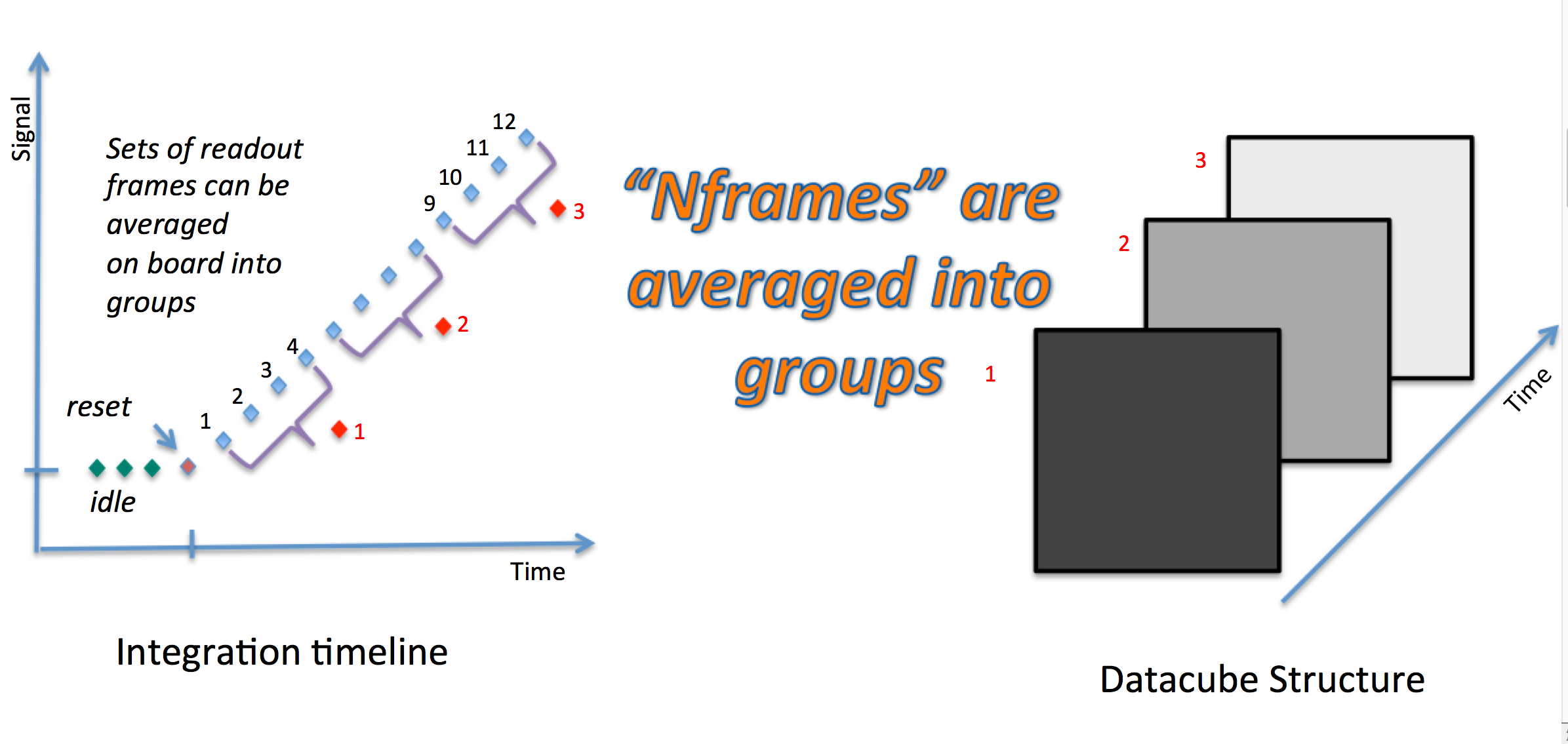NIRSpec Detector Readout
The JWST NIRSpec detectors sample pixels in MULTIACCUM up-the-ramp exposures.
On this page
The NIRSpec detectors (sensor chip assemblies; SCAs) operate in MULTIACCUM mode, meaning that the charge in each pixel may be sampled (read out) multiple times as it accumulates during an integration. The readout process is non-destructive, leaving accumulated charge unaffected and in place. Hence, charge is not transferred between pixels as in charge-coupled devices (CCDs). These non-destructive up-the-ramp readouts offer several advantages:
- They allow for an increase in the measurable dynamic range by recording the signal in pixels before they reach saturation.
- They allow for detection of cosmic rays and the possibility of recovering the incoming flux (in data processing).
- They permit fitting to multiple up-the-ramp reads to provide a means for reducing the net effective read noise.
At the end of an integration, each pixel is read out a final time and then reset, thereby releasing its charge. In order to maintain thermal stability, pixels are constantly read or reset at a fixed cadence (10 µsec per pixel). To increase the readout speed and maintain low power consumption, each SCA has 4 output channels that are being read simultaneously, with each channel covering a region of 512 × 2048 pixels. The channels are visible in the raw data as thick bands aligned with the NIRSpec dispersion direction. This alignment minimizes calibration difficulties in spectra that would otherwise span multiple outputs. The SCAs can also be read out in a subarray mode in which only a contiguous rectangular subset of pixels is recorded from each SCA, using a single output channel. NIRSpec subarray readout mode can be used in fixed slit (FS) or bright object time-series (BOTS) observing modes for bright sources that would cause pixel saturation even with the minimum full frame readout time.
NIRSpec detector readout definitions
Modes
NIRSpec offers 2 different readout modes. The traditional detector readout mode is the same as the NIRCam and NIRISS readout modes. This readout mode can be used for full frame or subarray readout. In addition, in order to meet strict noise performance requirements, NIRSpec also offers a noise reduction mode called improved reference sampling and subtraction, or IRS2. The IRS2 mode is only available for full frame readouts (i.e., not for subarrays) and is recommended for all full frame observations because of better read noise performance.
Frames
The unit of data that results from sequentially clocking through and reading out a rectangular area of pixels is called a frame. The unit of time needed to read out a frame is called frame time and it depends on the size of the area read out and on the readout mode. In full frame mode, i.e., when reading out the entire SCA, it takes about 10.7 s in traditional readout mode, and about 14.6 s in IRS2 mode. Shorter frame times can be achieved in traditional readout by selecting a dedicated subarray.
Groups
In order to reduce data volume and enable longer integrations, multiple frames can be averaged in the onboard focal plane processor. The averaged frames are referred to as one group. Table 1 lists the available NIRSpec readout patterns. Each of the 2 main readout modes (traditional or IRS2) has 2 different readout patterns. By selecting one of the NIRSpec readout patterns, users may either save all individual readout frames (each Groups = N, Frames = 1; Figure 1) or averaged groups of frames (Figure 2).
Integrations
Multiple groups of non-destructive reads are generally taken consecutively, resulting in an integration ramp for each pixel. Integrations are terminated by a reset, which clears accumulated charge from the pixels. The result of the NIRSpec detector readout is a 3-D data cube that has x and y detector pixels and flux ramps in the z dimension (Figures 1 and 2).
Exposures
Words in bold are GUI menus/
panels or data software packages;
bold italics are buttons in GUI
tools or package parameters.
The longest single integration multiaccum ramp time is recommended to be 1,500 seconds to balance noise effects and optimize cosmic ray rejection. Using multiple integrations for exposures longer than 1,500 seconds can allow for longer on-source times, up to the maximum exposure duration limit of 10,000 s. Longer exposure times will require the use of separate exposures (except in BOTS mode).
Table 1. Available NIRSpec detector readout patterns
Detector readout mode | NIRSpec readout pattern name | Nframes per group | Group time (s) | Unprocessed data size (one integration) |
| Traditional | NRSRAPID | 1 | 10.737 | 2048 pixels × 2048 pixels x Ngroups |
| NRSRAPIDD1 †,‡ | 1 | 21.474 | ||
| NRSRAPIDD2 †,* | 1 | 32.210 | ||
| NRSRAPIDD6 §,¶ | 1 | 75.159 | ||
| NRS | 4 | 42.947 | ||
NRSIRS2RAPID | 1 | 14.589 | 3200 pixels × 2048 pixels x Ngroups | |
| NRSIRS2 | 5 | 72.944 |
† NRSRAPIDD1 and NRSRAPIDD2 are used for MSATA target acquisition only.
‡ NRSRAPIDD1 reads one frame and drops one.
* NRSRAPIDD2 reads one frame and drops two.
§ NRSRAPIDD6 reads one frame and drops six.
¶ NRSRAPIDD6 is available for TA only (WATA or MSATA).


